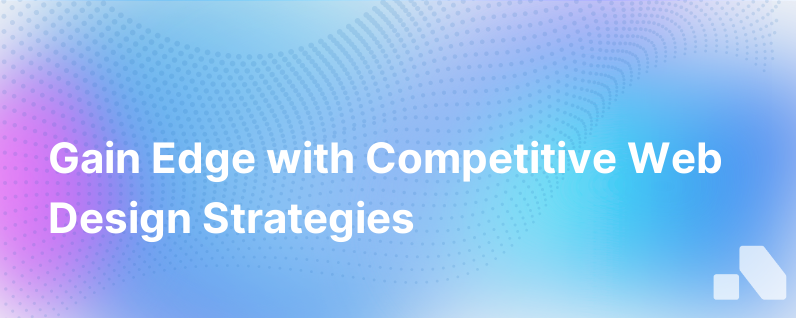
As we look around, we find that competitive web design is no longer just about aesthetics. It's about understanding and adapting to consumer behavior, technological advancements, and industry nuances, especially for B2B companies. In this sphere, the purpose shifts from mere decoration to strategic differentiation and communication, where web design becomes a critical tool in your sales arsenal.
Here's an in-depth guide on how to leverage competitive web design for maximum impact in your B2B sales strategy.
Understanding the Interface as a Sales Conversation
The heart of any sales interaction is communication and understanding the customer’s needs. Your website’s design must facilitate and mimic this conversation. Customization and adaptability of design, in real time and in response to user actions, can set your site apart. Employ AI-driven design to create an interactive experience that echoes a dynamic sales conversation [[1]].
Integrate Dynamic Personalization
Data analytics enable dynamic personalization, with AI algorithms utilizing user interaction data to optimize the site experience on the fly. High-performing B2B websites use A/B testing and analytics to perfect their designs, speaking directly to distinct user segments [[1]].
Implementing User-Centric Design
Websites must be built with the end user in mind. The top B2B players conduct extensive user experience (UX) research, creating intuitive sites that cater to a visitor’s need for information, clarity, and swift navigation. They craft a UX narrative that mirrors the typical buyer’s journey, making the complex appear simple and approachable [[7]].
Mobile-First Philosophy
With the undeniable prevalence of on-the-go business, mobile optimization is not optional. A responsive, mobile-first design ensures that your website is accessible from any device, supporting sales interactions at any moment and in any context [[3]] [[6]].
Leverage Design to Communicate Value Proposition
Your visual narrative is an influential sales tool. Utilizing high-quality imagery, infographics, and videos can translate complex B2B offerings into digestible, relatable content. These elements must be more than merely decorative – they're instrumental in conveying your unique value proposition and establishing a visual hierarchy that guides users to key content [[2]].
Pushing Brand Identity through Consistency
A B2B website should embody the brand. Design uniformity not only fortifies brand recognition but also creates a trust foundation between you and your audience. This trust is essential in long B2B sales cycles and high-stake transactions. Meanwhile, design consistency contributes to user predictability, aiding navigability and reducing cognitive load [[3]].
Optimizing for Conversion and Performance Metrics
Analytics and conversion rate optimization (CRO) are indispensable in aligning web design with sales goals. Employ heatmaps, scroll maps, and click tracking to improve site elements that underperform and to enhance those that customers find the most value in. CRO should be an iterative, ongoing process to refine user paths to conversion [[8]].
Search Engine Optimization (SEO)
SEO plays an indispensable role in competitive web design for B2B sales. It widens your funnel by increasing visibility and organic traffic. SEO considerations should be baked into the design process, focusing on aspects like site structure, technical performance, and content readability [[5]] [[6]].
Infusing Design with Technology and Innovation
If you want to stand out, push the boundaries of design with the latest technologies. Augmented reality (AR), virtual reality (VR), and interactive 3D modelling revolutionize how customers interact with your products, fostering engagement and accelerating the sales process.
Voice optimization is yet another frontier. Voice search capabilities can make it easier for users to find and interact with your site, catering to the rapidly growing voice search trend [[6]].
Accessibility as a Priority
Inclusivity in web design speaks volumes about your brand's ethos, offering an untapped opportunity to reach wider demographics. It's imperative that your design complies with accessibility standards, ensuring that the site is usable for people with disabilities. This commitment to accessibility not only broadens your reach but aligns with corporate responsibility and inclusive business practices [[3]] [[7]].
Building for Scalability and Flexibility
Your web design should not be a static monument but a flexible framework capable of evolving with your business. Implement a CMS that allows for quick updates, content changes, and the addition of new features or tools as your sales strategies and tactics develop.
A Focus on Quality Content
A website rich in quality, insightful content not only serves to educate but also to persuade and build credibility. Your content should be crafted for target personas, addressing specific pain points and providing solutions that resonate with the B2B audience.
Competitive Analysis and Continuous Improvement
Never stand still – monitor competitors and stay abreast of design trends. Regular audits of your site performance, design, and content can reveal areas for improvement and innovation [[4]].
Harnessing the Power of Client Testimonials and Case Studies
Demonstrate credibility and build trust through client testimonials, case studies, and success stories. Use these elements as social proof to support your B2B sales narrative.
Sources:
- 7 emerging web design trends for 2024 and beyond | Webflow Blog
- 41 Latest Web Development Trends in 2024 [Updated]
- Top Web Design Trends 2024 - Designmodo
- 15 Latest Web Development Technologies You Should Know About
- 7 New Web Design Trends & Predictions for 2024
- 11 Web Development Trends to Expect in 2023, According to Experts & Data
- Top 10 Web Design Companies of 2024
- Top 50 Web Design Companies - 2024 Reviews | Clutch.co